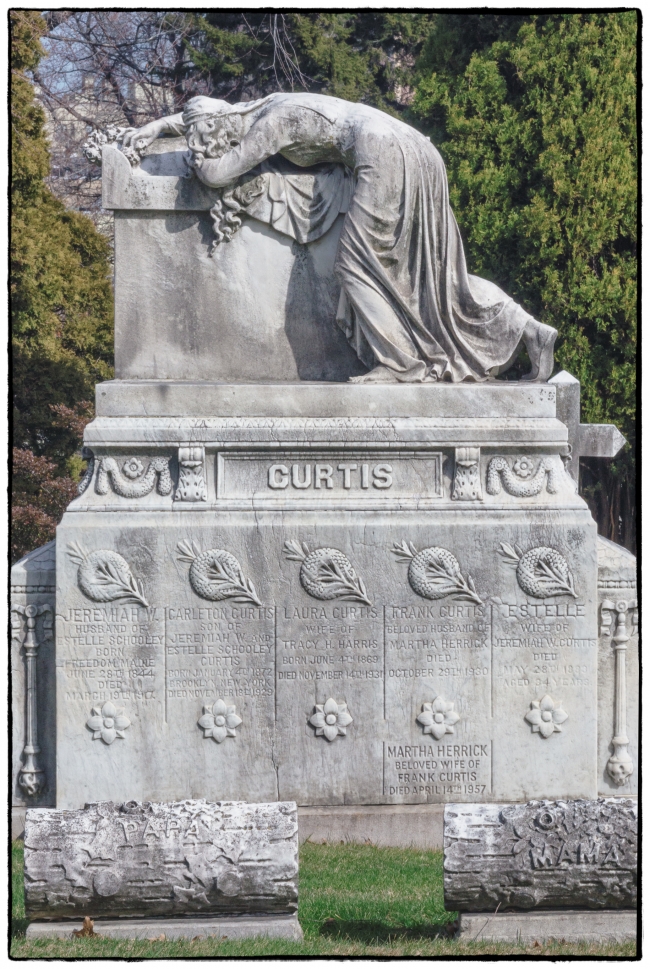I was attracted to the statue on this memorial, but had a hard time finding information on the family to whom it belonged. The name “Jeremiah W. Curtis” seemed prominent and finally in “Reports of Cases Argued and Determined in the Court of Common Pleas for the City and County of New York”. By Charles P. Daly, LL. D., First Just. of the Court, Vol II., New York, Baker, Voorhis and Co., Law Publishers, 6 Nassau Street, 1870 I found this extract:
By the Court – Van Vorst, J. Previous to the year 1844, Mrs. Charlotte N. Winslow prepared a composition for children teething, which she used with success. In 1844, she gave the recipe to her son-in-law, Jeremiah curtis, one of the plaintiffs in this action, who commenced its manufacture and sale, under the name “Mrs Winslow’s Soothing Syrup,” and with the approval of Mrs. Winslow, made that his trademark. Afterward Jeremiah Curtis associated with himself in business Benjamin A. Perkins. Curtis and Perkins, from and after the year 1845, prepared, manufactured and sold the preparation under the same name and trade mark. Before the year 1852, they used a wrapper and label generally resembling that now in use. In 1852, they invented a wrapper, which has been continued from that time to the present.
In the year 1855, Perkins retired from the co-partnership, and George Newman Curtis and Jeremiah W. Curtis, with the plaintiff Jeremiah Curtis, became the proprietors of said article, title, and name, and are the present proprietors of the recipe for the medicine, and the trad-mark.
So it seems that the Curtis family was connected to Mrs Winslow’s Soothing Syrup, whatever that was. Going further I discovered that it was quite controversial. According to an article (Mrs. Winslow’s Soothing Syrup – oooh so soothing) on Peachtree Glass (apparently the bottles it was sold in are collectible):
The formula consisted of Morphine Sulphate (an opiate analgesic related to heroin), sodium carbonate (water softener), spirits foeniculi (an alcohol that seems to be only associated with this product), and aqua ammonia (a cleaning agent). I can not even begin to imagine what this may have tasted like. Probably wouldn’t matter.
…
In 1911, the American Medical Association put out a publication called “Nostrums And Quackery” (pictured above) where, in a section called “Baby Killers”, it incriminated Mrs. Winslow’s Soothing Syrup. It was not withdrawn from sale in the UK until 1930.
In 1879 the English composer Edward Elgar (pictured above) wrote an early musical work, part of his Harmony Music for a wind quintet, which he titled Mrs Winslow’s soothing syrup.
In a find a grave record for George N. Curtis, Jeremiah W. Curtis is mentioned as his brother. If this is correct then Laura Curtis Bullard would have been a sister to both Jeremiah W. Curtis and George Newman Curtis.
According to Wikipedia
Laura Curtis Bullard (1831–1912) was an American writer and women’s rights activist. She founded a newspaper called The Ladies’ Visitor, and Drawing Room Companion and published two novels with women’s rights themes, the best known of which is Christine: or, Woman’s Trials and Triumphs. She was elected as a corresponding secretary for the National Woman Suffrage Association, led by Elizabeth Cady Stanton and Susan B. Anthony, at its founding meeting. She succeeded Stanton as editor of The Revolution, a women’s rights newspaper founded by Stanton and Anthony.

